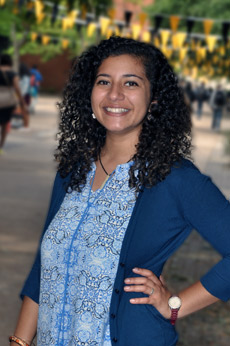Interdisciplinary Studies
“Exploring Potential Benefits of Three-Dimensional Printing Technology in Elementary School Settings”

With the increased availability of three-dimensional (3D) printing technologies on the consumer market, educational settings have begun to explore their use within the traditional curriculum. As part of a longitudinal study, our research team is conducting weekly 3D modeling and printing workshops at a Baltimore school. The workshops are part of an after-school education program designed to support at most 20 students in third and fourth grade who may be at-risk. Since the school is located in an under-served area, we are able to observe the reactions and perceptions of 3D printing among students who may not be regularly exposed to the latest technologies. By observing and recording the students’ reactions, collaborations, and frustrations while learning 3D modeling and printing in this setting, we are able to observe benefits and repercussions of 3D modeling and printing in an educational setting. We utilized the method of comparing students’ understanding of the technology in 2D drawings from the time of their initial exposure to their understanding at the end of the school year. We foresee that the findings of this research may help to inform the design of future curriculum, and 3D modeling and printing software tools.
This work is supported, in part, by the National Science Foundation under Grant No. IIS-1451661.
What research experiences have you had?My most recent research experiences have been in the field of Human-Computer Interaction (HCI). I love this field because it focuses on the intersection of technology we use, how it affects us, and how we could design technology to improve that interaction. In particular, with an amazing team of graduate students in the Prototyping and Design (PAD) Lab, I have been exploring the potential uses of three-dimensional (3D) printing and modeling in an elementary school classroom. My summer internship was also in the field of HCI, in the HCI Lab at University of North Carolina, Charlotte. I was investigating practices of inclusivity in technically oriented spaces, which have become more popular in the past few years.
How did you find the research opportunity?I found my research opportunity in the PAD Lab by speaking with a professor I trust about my interests and she referred me to the work being done under Dr. Amy Hurst in the PAD Lab. Once I got involved in the lab, I received guidance from Dr. Hurst and one of her graduate students, Erin Buehler, to get me working on a project I’d enjoy.
Who is your mentor for your research, scholarship, or artistic project? How did you arrange to work with this person?My mentor for my research at UMBC is Dr. Amy Hurst in the Information Systems Department. I emailed Dr. Hurst asking if I could get involved in the PAD Lab and she welcomed me to the lab’s weekly meeting where I heard about many of the ongoing projects in the lab and continued contact with the graduate students whose work I was most interested in.
Do you get course credit for this work? Paid? How much time do you put into it?I received course credit for my work in the PAD Lab and got paid for my experience over the summer. During the semester, I work 10 hours a week and over the summer I worked 40 hours a week.
What academic background did you have before you started?My academic background before I started was the first two years of the Computer Engineering curriculum. This included a lot of math courses, as well as introductory physics, and computer science courses.
How did you learn what you needed to know to be successful in this project?I learned what I needed for my project from the graduate students I work under, online resources, and by trying out the machines on my own. I am constantly finding that I need to know more, so I never miss a chance to ask questions of my best resources—our lab members!
What was the hardest part about your research?I think the hardest part of my research is how interdisciplinary the questions are that we are trying to answer. They require knowledge from many different fields, being bridged and accounted for in order to efficiently achieve our goals.
What is your advice to other students about getting involved in research?My advice to others becoming involved in research is to spend time reading about topics that you are interested in, so that you can become involved in research that you truly care about. I think that makes for the best experience, because then you won’t mind the work that is required to achieve your team’s goals.
What are your career goals?I will continue my career in research by becoming formally trained as a researcher in a Ph.D. program and hopefully improve upon our understanding of the interaction that children have with technology and how to design their technology to accordingly better that interaction.
What else are you involved in on campus?I am also involved with the Computer Science Education club and the Orthodox Christian groups on campus.